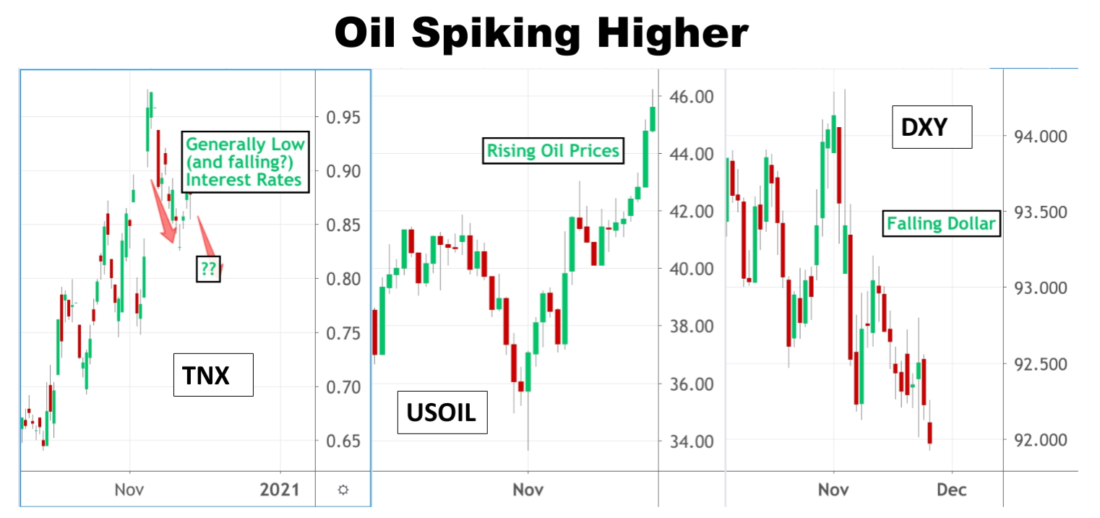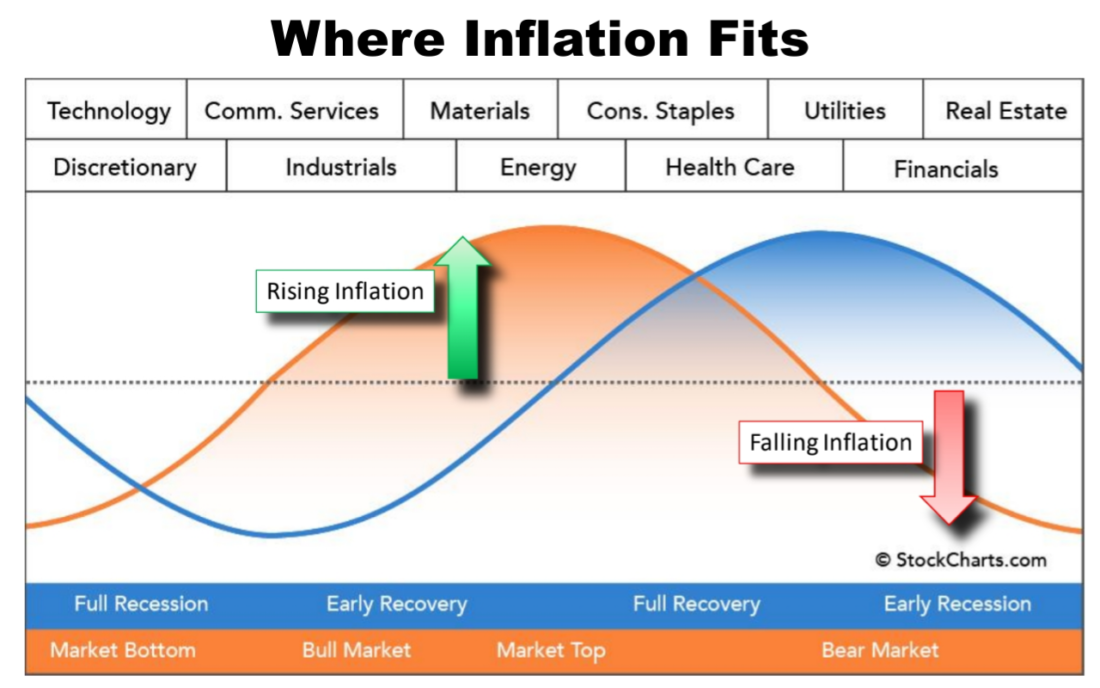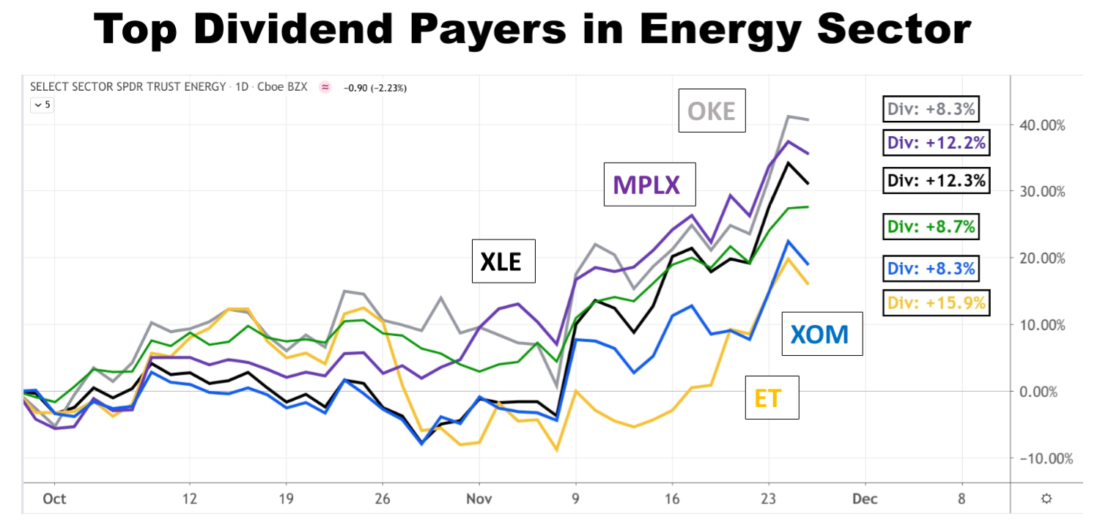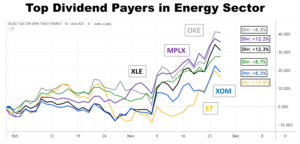Wednesday, November 25, 2020 Headlines
1. Signs of inflation continue to pop up throughout the market
2. Inflation and the business cycle
3. Dividend stocks in the energy sector
Market Moves
Inflation tends to run complementary with the business cycle. The good news about inflation is that it means generally higher prices for everything, including stocks. The bad news about inflation is that if you aren’t invested in stocks, then you must pay more for everything without having more to pay for it with. Signs of inflation give investors a strong incentive to participate in the market. That notion adds a second reason (beyond a COVID-19 vaccine) for why stocks are rising to new highs.
The chart below displays three very strong indications that prices have risen and will continue to rise soon. Interest rates are historically low and may even be about to make a short-term dip lower. Oil prices are spiking higher on the anticipation of new demand. Lastly, the U.S. Dollar is continuing to fall lower.
All of these imply higher relative, and actual, prices for goods in the market. Astute chart watchers can use this information to help them recognize where markets may be positioned in terms of the business cycle.

Inflation and The Business Cycle
Analysts often generalize about how the market and the economy run in similar cycles. In a model, popularized by analyst and author Sam Stovall, the economic cycle lags the market cycle by six to nine months. As the market rises and falls throughout the cycle, different sectors come into favor among investors.
The chart below is courtesy stockcharts.com, but the inflation notations are my own. The concept here is that at certain points in the cycle, prices begin to rise or fall. Chart watchers can tell where they are in the cycle depending on which sectors appear to be favored by investors.
Right now, the evidence is clear that the market is in the latter part of its bull market phase, and it is only natural that we should expect to see strong performance from energy and materials sectors.
When these sectors move higher rapidly (as they are now), investors can naturally expect to see inflation as prices rise on basic materials and energy supplies. When markets are falling, inflation is low and sometimes going lower.


Dividend Stocks in the Energy Sector
The combination of inflation signals and a sector rotation towards energy and materials stocks means that certain stocks may be particularly attractive to investors. The chart below compares the top five dividend-paying large-cap energy stocks. Dividend paying stocks are very attractive to investors when the market experiences lower interest rates. That’s because these dividends represent an alternative to the lower interest rates. It goes without saying that if the energy sector is on the rise, these high-dividend stocks might pay out a handsome return.


The Bottom Line
Signs of inflation abound, and chart watchers should recognize that this means we are leading up to a market top eventually. Until then energy stocks, especially those paying large dividends, should be the focus for most investors.
—
Originally Published on November 25, 2020
Disclosure: Investopedia
Investopedia.com: The comments, opinions and analyses expressed herein are for informational purposes only and should not be considered individual investment advice or recommendations to invest in any security or to adopt any investment strategy. While we believe the information provided herein is reliable, we do not warrant its accuracy or completeness. The views and strategies described on our content may not be suitable for all investors. Because market and economic conditions are subject to rapid change, all comments, opinions and analyses contained within our content are rendered as of the date of the posting and may change without notice. The material is not intended as a complete analysis of every material fact regarding any country, region, market, industry, investment or strategy. This information is intended for US residents only.
Disclosure: Interactive Brokers
Information posted on IBKR Campus that is provided by third-parties does NOT constitute a recommendation that you should contract for the services of that third party. Third-party participants who contribute to IBKR Campus are independent of Interactive Brokers and Interactive Brokers does not make any representations or warranties concerning the services offered, their past or future performance, or the accuracy of the information provided by the third party. Past performance is no guarantee of future results.
This material is from Investopedia and is being posted with its permission. The views expressed in this material are solely those of the author and/or Investopedia and Interactive Brokers is not endorsing or recommending any investment or trading discussed in the material. This material is not and should not be construed as an offer to buy or sell any security. It should not be construed as research or investment advice or a recommendation to buy, sell or hold any security or commodity. This material does not and is not intended to take into account the particular financial conditions, investment objectives or requirements of individual customers. Before acting on this material, you should consider whether it is suitable for your particular circumstances and, as necessary, seek professional advice.



























